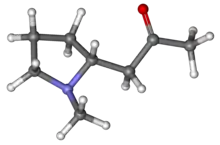 | |
 | |
| Names | |
|---|---|
| Preferred IUPAC name
1-[(2R)-1-Methylpyrrolidin-2-yl]propan-2-one | |
| Identifiers | |
3D model (JSmol) |
|
| ChEBI | |
| ChemSpider | |
| ECHA InfoCard | 100.007.112 |
| KEGG | |
PubChem CID |
|
| UNII | |
CompTox Dashboard (EPA) |
|
| |
| |
| Properties | |
| C8H15NO | |
| Molar mass | 141.21 g/mol |
| Boiling point | 193 to 195 °C (379 to 383 °F; 466 to 468 K) |
Except where otherwise noted, data are given for materials in their standard state (at 25 °C [77 °F], 100 kPa).
Infobox references | |
Hygrine is a pyrrolidine alkaloid, found mainly in coca leaves (0.2%). It was first isolated by Carl Liebermann in 1889 (along with a related compound cuscohygrine) as an alkaloid accompanying cocaine in coca. Hygrine is extracted as a thick yellow oil, having a pungent taste and odor.
See also
References
- Dr. Ame Pictet (1904). The Vegetable Alkaloids. With particular reference to their chemical constitution. London: Chapman & Hall.
- "Hygrine". Webster's Revised Unabridged Dictionary (? ed.). 1913.
- "USDA, ARS, National Genetic Resources Program. Phytochemical and Ethnobotanical Databases. National Germplasm Resources Laboratory, Beltsville, Maryland". Archived from the original on December 11, 2012. Retrieved July 15, 2005.
This article is issued from Wikipedia. The text is licensed under Creative Commons - Attribution - Sharealike. Additional terms may apply for the media files.